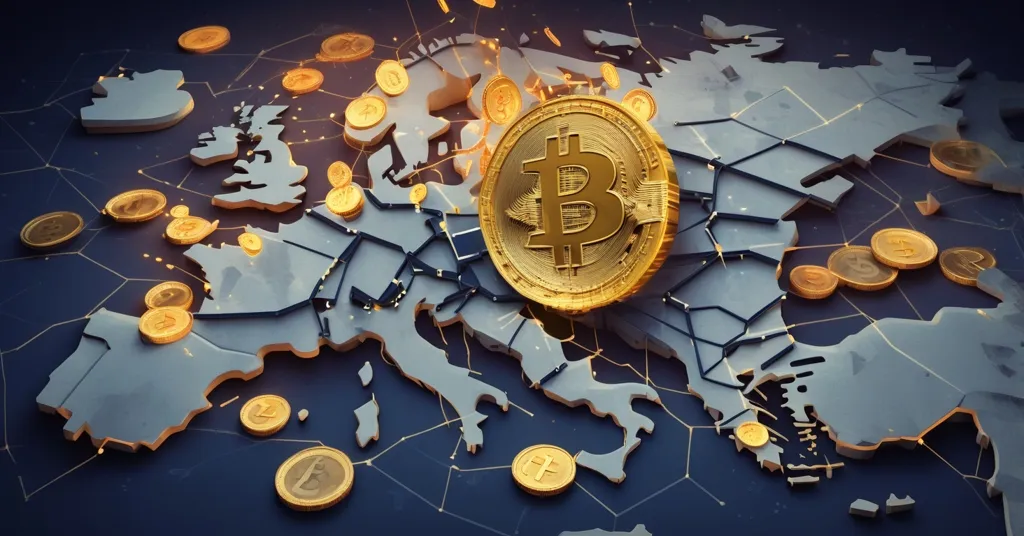Eurozone Growth Stalls at 0.1% in Q2 2025: Can Bitcoin and DeFi Save the Day?

Eurozone Limps Along with 0.1% Q2 Growth in 2025 as Trade Wars Bite—Could Bitcoin Be the Fix?
The Eurozone economy is teetering on the edge, scraping by with a meager 0.1% growth in the second quarter of 2025, according to Eurostat. This slowdown, a sharp drop from the 0.6% growth in Q1, comes as global trade tensions—driven by U.S. tariffs under Donald Trump’s latest protectionist push—squeeze the life out of European markets. But as centralized systems falter under the weight of trade wars, could decentralized solutions like Bitcoin and blockchain offer a way out of this mess?
- Sluggish Growth: Eurozone GDP grew by just 0.1% in Q2 2025, down from 0.6% in Q1, per Eurostat.
- Trade War Fallout: U.S. tariffs, including a 15% duty on most European imports since April 2025, are crippling trade flows.
- Regional Divide: Germany contracted by 0.1%, while France and Spain posted gains of 0.3% and 0.7% respectively.
The Numbers Paint a Grim Picture
Let’s cut to the chase: 0.1% growth is barely a pulse. While it edged out the flatline forecast by economists polled by Reuters, it’s a far cry from the healthier Q1 figures. That earlier growth was a fluke, fueled by what’s known as tariff frontloading—a mad dash by businesses to import goods before Trump’s tariffs jacked up costs in April 2025. With a 15% duty slapped on most European exports to the U.S., plus lingering sector-specific tariffs on automobiles, steel, and aluminum (though some were scaled back), the uncertainty has businesses sweating bullets. The result? A region-wide economic slowdown that’s exposing deep cracks in the Eurozone’s foundation.
Jack Allen-Reynolds, deputy chief Eurozone economist at Capital Economics, saw this coming from a mile away.
The slowdown in euro-zone GDP growth in Q2 came as no surprise as the boost from tariff front-running waned… The euro-zone has been resilient to the shifts in US trade policy so far… the impact of trade policy uncertainty has seemingly been limited so far.
Resilient? Maybe. But limping along at 0.1% isn’t exactly a victory lap. It’s more like surviving a slap in the wallet while waiting for the next hit.
Regional Disparities: Germany Sinks, Others Hold Ground
Digging into the country-by-country breakdown, the Eurozone’s economic divide couldn’t be starker. Germany, the industrial juggernaut, took a punch to the gut with a 0.1% contraction, down from 0.3% growth in Q1. Declines in construction and industrial investment are dragging it under, and recovery looks like a slog. Carsten Brzeski from ING didn’t sugarcoat it:
The return to growth [in Germany] and a strong economy remains a long and complicated project.
Ulrich Kater of Deka Bank piled on, pointing out that even as the tariff chaos settles,
economic momentum in Germany remains weak, especially in comparison with many European neighbours.
Meanwhile, France and Spain are weathering the storm better. France clocked in at 0.3% growth, beating expectations of a measly 0.1%, while Spain shone with a robust 0.7%, up from 0.6% in Q1, thanks to strong domestic demand. ECB President Christine Lagarde tried to spin this patchwork performance into gold, saying the economy did
slightly better than the central bank had expected so far this year,
and called the Eurozone’s position
a good place.
A good place? Tell that to German manufacturers staring down the barrel of shrinking order books, especially with the latest Q2 growth data confirming the dire state of affairs.
Trade Wars: A Gut Punch to Key Sectors
These U.S. tariffs aren’t just abstract policy—they’re hammering real industries. Automobiles, pharmaceuticals, luxury goods, furniture, and machinery, which form massive chunks of EU exports to the U.S., are all feeling the burn. Analyst Gary Hufbauer from the Peterson Institute for International Economics predicts a 10% price hike for European autos in the U.S. market due to razor-thin margins. Ernie Tedeschi of Yale Budget Lab crunched the broader impact, estimating a 1.8% price increase across affected goods—equivalent to a $2,400 loss in household income. That’s not chump change; it’s like losing a year’s worth of groceries to bureaucratic bickering over Trump’s tariff policies.
Beyond direct costs, the ripple effects are nasty. Uncertainty over trade deals (or lack thereof) and the risk of Chinese goods flooding Europe as a byproduct of U.S.-China spats are adding fuel to the fire. It’s economic violence, plain and simple, and it shows just how fragile centralized trade systems are when politicians play hardball.
Centralized Systems in Crisis: ECB and Germany’s Big Gamble
With the Eurozone floundering, the European Central Bank (ECB) is caught in a high-stakes game of economic hot potato. Market odds for an interest rate cut by October 2025 sit at a coin toss—50-50—reflecting deep uncertainty. Riccardo Marcelli Fabiani of Oxford Economics noted that the limited setback from tariffs
will make ECB policymakers more reluctant to cut.
Translation: don’t expect a lifeline from monetary policy anytime soon. The ECB’s digital euro project, hyped as a modern solution, is just another centralized tool—more about control than innovation. It’s not disrupting anything; it’s just repackaging the same old problems.
Over in Germany, Chancellor Friedrich Merz is rolling the dice with a proposed €1 trillion investment plan, loosening borrowing limits to stimulate growth. Bold? Sure. Reckless? Possibly. Critics are already warning it could turn into a world champion of waste if mismanaged, as discussed in recent online debates about Germany’s economic contraction. Compare that to Spain’s stability, driven by internal demand, and you’ve got a classic Eurozone split: export-heavy economies like Germany are getting crushed, while others dodge the worst of the tariff storm.
Bitcoin and DeFi: A Decentralized Lifeline?
Here’s where things get interesting for us crypto heads. Traditional systems are failing spectacularly under the weight of trade wars—so why not turn to decentralized alternatives? Bitcoin, as a borderless store of value, could act as a hedge against the inflation and price hikes these tariffs are triggering. Historically, during inflationary spikes like 2021-2022, Bitcoin has shown resilience as a safe haven (despite its own volatility). Current on-chain data reflects growing adoption, with wallet counts and transaction volumes ticking up even in bearish cycles. It’s a middle finger to protectionist nonsense—Bitcoin doesn’t care about Trump’s tariffs or ECB dithering, and could be a viable inflation hedge during trade wars.
But let’s not stop at BTC. Decentralized finance (DeFi) on platforms like Ethereum offers a way to rethink trade entirely. Smart contracts—automated agreements on a blockchain that execute without middlemen—could slash costs and bypass the red tape of centralized trade barriers. Imagine cross-border deals settled instantly, without banks or governments taking their cut. Projects like Centrifuge on Ethereum are already piloting trade finance solutions through DeFi, tokenizing real-world assets to fund supply chains. Even if Bitcoin remains king as a store of value, Ethereum’s utility or Solana’s speed could fill niches BTC wasn’t built for, like high-volume trade settlements.
That said, don’t pop the champagne just yet. Crypto isn’t a silver bullet. Bitcoin’s transaction speed is still a bottleneck without the Lightning Network fully scaling, and Ethereum’s gas fees can sting during network congestion. Plus, volatility remains a beast—just look at BTC’s 2022 nosedive. Can it handle global trade volumes anytime soon? Skeptics say no, and they’ve got a point. But with layer-2 solutions and infrastructure maturing, the gap is closing fast.
EU Regulations: Stifling the Crypto Revolution
Here’s the rub: even if crypto offers a way out, the EU’s regulatory chokehold is a massive roadblock. The Markets in Crypto-Assets (MiCA) framework, designed to protect consumers and ensure market stability, comes with sky-high compliance costs that strangle startups and slow DeFi adoption. It’s a classic case of centralized overreach—trying to tame a wild west that thrives on freedom. The digital euro, meanwhile, is just the ECB’s attempt to slap a blockchain sticker on fiat control. It’s not decentralization; it’s a surveillance state in disguise.
For Bitcoin maximalists like myself, this is why BTC’s ethos of privacy and autonomy matters more than ever. But I’ll concede altcoins have a role—Ethereum’s smart contracts or Polkadot’s cross-chain bridges could tackle trade inefficiencies in ways Bitcoin isn’t meant to. Still, until the EU loosens its grip, crypto’s potential in Europe remains a pipe dream. We’re stuck watching centralized systems flail while the tools for disruption sit on the sidelines, as many discuss in platforms like online forums about tariff impacts.
Looking Ahead: Accelerating Toward Decentralization
Trade wars like these are the spark; blockchain and crypto are the wildfire waiting to spread. If anything, this Eurozone mess proves why we need to accelerate decentralized tech—call it effective accelerationism in action. Centralized failures, from tariffs to ECB indecision, are pushing us toward a tipping point where Bitcoin and DeFi aren’t just nice-to-haves; they’re inevitable. Imagine a world where trade doesn’t grind to a halt over political spats because it runs on immutable, borderless rails. We’re not there yet, but every tariff hike brings us closer, with many seeking answers on how U.S. tariffs impact Eurozone economies.
Markets didn’t flinch much at the Eurostat numbers—the euro held at $1.155, and French and German bond yields barely budged. Maybe investors are numb, or maybe they’re betting on a last-minute trade deal. Either way, the real story is the systemic fragility on display. For crypto enthusiasts, this is a screaming reminder of why we fight for decentralization. If trade policies can kneecap entire regions overnight, then Bitcoin’s rebellion against the status quo isn’t just ideology—it’s survival. Let’s keep pushing, one block at a time, backed by verified economic data for Q2 2025.
Key Questions and Takeaways
- What caused the Eurozone’s economic slowdown in Q2 2025?
A drop to 0.1% growth was driven by U.S. tariffs, including a 15% duty on European imports since April 2025, and the fading boost from pre-tariff import rushes in Q1. - How are Eurozone countries performing differently?
Germany contracted by 0.1% due to industrial declines, while France grew by 0.3% and Spain by 0.7%, buoyed by domestic demand. - What’s the consumer impact of these trade wars?
Tariffs are hiking prices by 1.8% on goods like cars and luxury items, costing households an estimated $2,400 in income—equivalent to a year’s inflation beyond targets. - Can Bitcoin act as an inflation hedge against tariff impacts?
Yes, Bitcoin’s history as a store of value during inflationary periods like 2021-2022 makes it a potential shield, though volatility and scaling issues remain hurdles. - How could DeFi solve trade inefficiencies?
Decentralized finance, via smart contracts on platforms like Ethereum, could enable instant, low-cost cross-border trade, bypassing tariffs and intermediaries— if regulations allow. - What’s holding crypto back in the Eurozone?
Strict EU regulations like MiCA impose high compliance costs, stifling DeFi and crypto adoption, while the digital euro prioritizes control over true decentralization. - Is Germany’s €1 trillion plan a fix or a fiasco?
It’s a high-stakes bet to revive growth, but skeptics warn it could become a wasteful disaster if not executed with precision.



